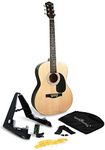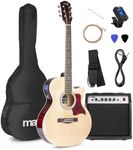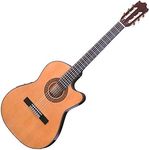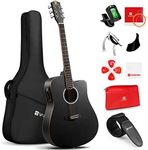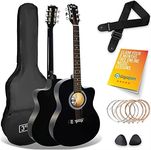Buying Guide for the Best Acoustic Guitars For Beginners
Choosing the right acoustic guitar as a beginner can greatly influence your learning experience and enjoyment. It's important to find a guitar that feels comfortable, sounds good to your ears, and suits your musical interests. Start by considering the type of music you want to play, your physical comfort with the instrument, and the sound quality you desire. Remember, the best guitar for you is one that you will enjoy playing and practicing with regularly.Body ShapeThe body shape of an acoustic guitar affects both the sound and the comfort of playing. Common shapes include dreadnought, concert, and parlor. Dreadnoughts are larger and produce a louder, bass-heavy sound, making them great for strumming and playing in groups. Concert and parlor guitars are smaller, offering a more balanced tone and are easier to handle, especially for smaller players or those who prefer fingerpicking. Choose a body shape that feels comfortable to hold and suits the style of music you want to play.
TonewoodTonewood refers to the type of wood used in the construction of the guitar, which significantly influences the sound. Common tonewoods include spruce, mahogany, and cedar. Spruce is known for its bright and clear sound, making it versatile for various music styles. Mahogany offers a warmer, more mellow tone, ideal for blues and folk. Cedar provides a softer, warmer sound, often preferred for fingerstyle playing. Consider the sound characteristics you prefer and choose a tonewood that aligns with your musical taste.
Neck WidthThe neck width of a guitar affects playability, especially for beginners. A narrower neck is easier for small hands to navigate, making it suitable for younger players or those with smaller hands. A wider neck provides more space between strings, which can be beneficial for fingerstyle playing. Try different neck widths to see which feels most comfortable for your hand size and playing style.
Scale LengthScale length is the distance from the nut to the bridge of the guitar and affects string tension and playability. A shorter scale length results in less string tension, making it easier to press down the strings, which is helpful for beginners. A longer scale length offers more tension, which can produce a brighter sound but may be harder to play. Consider your hand strength and comfort when choosing a scale length.
ActionAction refers to the height of the strings above the fretboard. Lower action makes it easier to press the strings down, which is beneficial for beginners as it reduces finger fatigue. However, if the action is too low, it can cause buzzing. Higher action can produce a clearer sound but requires more finger strength. Test different guitars to find an action height that feels comfortable and produces a clean sound without buzzing.
Built-in ElectronicsSome acoustic guitars come with built-in electronics, allowing you to amplify the sound. This feature is useful if you plan to perform or record music. If you are just starting and focusing on learning, built-in electronics may not be necessary. However, if you foresee needing amplification in the future, consider a guitar with this feature. Decide based on your current and future playing needs.



